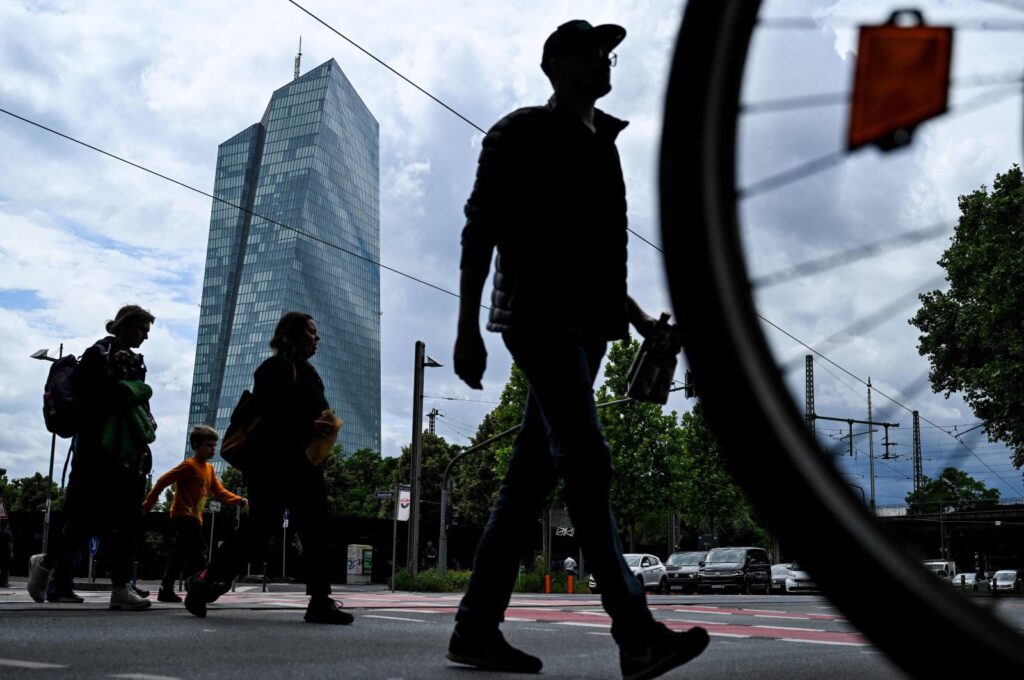The European economy posted modest growth in the April-June quarter even as the U.S. outperformed expectations, highlighting persistent transatlantic divergences with Germany, Europe’s biggest economy, continuing to struggle as cautious consumers choose to save rather than spend on big-ticket items such as homes and cars.
Gross domestic product (GDP), or the total production of goods and services, in the 20 euro zone countries rose 0.3 percent in the second quarter, beating economists’ expectations, official figures released on Tuesday by the European Union’s statistics office, Eurostat, showed.
The figure would support the European Central Bank’s view that it is in no rush to cut interest rates again so soon after its June cut.Analysts surveyed by FactSet and Bloomberg had expected growth of 0.2%.
The expansion followed a similar gain of 0.3 percent in the January-March quarter and was the first significant growth after more than a year of stagnation, with rates hovering just above zero, remaining at zero or below zero.
While the better-than-expected growth will please many, concerns about Germany remain and continue to weigh on the euro zone’s performance.
There are already warning signs in the European economy, with data released last week showing that euro zone business activity slowed further in July and manufacturing remains weak.
Eurozone “laggards”
Germany unexpectedly fell back into recession, with output falling 0.1 percent in the second quarter, the data showed.
“Overall, today’s data confirms once again that Germany is the euro zone’s growing laggard,” said Carsten Brzeski at ING Bank.
But he added: “While a recovery is still possible later this year, it is highly unlikely to be a strong one.”
In contrast, the U.S. economy grew 0.7% in the second quarter from the first, for an annualized rate of 2.8%.
American consumers are spending freely, but deficit-fueled government spending and subsidies for corporate investment in renewable energy, semiconductor production and infrastructure under the Inflation Control Act also contribute to the country’s growth.
These two trends are reversing in Europe, where consumers are saving at record levels and governments are beginning to restrict spending to reduce budget deficits.
“The US performance was mainly driven by strong private consumption and domestic investment,” said Thomas Obst, a senior economist at the German Institute for Economic Research in Cologne. “The US fiscal policy support was higher than in other developed countries, with total spending amounting to 25% of GDP.”
On the other hand, rising interest rates will have a smaller impact on lending and the economy than in Europe, he said.
France and Spain outperform expectations
In contrast to Germany, the euro zone’s second-largest economy, France, and fourth-largest, Spain, beat expectations, growing 0.3 percent and 0.8 percent respectively in the second quarter.
France is currently hosting the Olympics in Paris, which Capital Economics says should provide a “modest boost” to the eurozone economy in the third quarter of 2024.
In Spain, one of the region’s strongest economic growth countries, exports and solid household spending drove economic growth, while a recovery in foreign trade and business investment boosted production in France.
Southern Europe appears to be faring better than other parts of the continent.
Italy and Portugal recorded growth of 0.2% and 0.1% respectively.
Tuesday’s data also showed the European Union’s 27-nation economy expanded 0.3 percent in the second quarter.
All eyes will be on euro zone inflation data for July due to be released on Wednesday, with consumer prices rising above the ECB’s 2% target.
The sluggish growth in the first half of the year follows five straight quarters of virtually zero growth due to a surge in inflation that sapped consumers’ purchasing power.Energy prices have soared after Russia cut off most natural gas deliveries in 2022 over its invasion of Ukraine, and supplies of parts and raw materials have tightened as the global economy recovers from the pandemic.
Those headwinds have abated, but Europe faces lasting effects as new labor agreements lead to a delayed recovery in real wages and government aid and tax cuts aimed at mitigating the energy crisis are phased out as governments turn to reduce deficits that ballooned during the crisis.
Interest rate hikes by the European Central Bank helped slow inflation to 2.5% in June from 10.6% in October 2022, but they also curbed construction activity and blunted years of house price growth.New car sales rose 4.3% in the first half of this year compared with the same period last year but remain about 18% below pre-pandemic levels.
Another factor is the unusually high level of precautionary savings among European consumers: it reached 15.4% in the first three months of this year, the highest ever recorded outside of pandemic years. Reasons for saving more money could include the chance to earn higher interest rates on savings, feeling poorer due to falling house prices, or worries about the future despite a low unemployment rate of 6.4%.
Jack Allen Reynolds, deputy chief euro zone economist at Capital Economics, said high savings rates and consumer surveys suggested “the intention to make big purchases is extremely low”.

